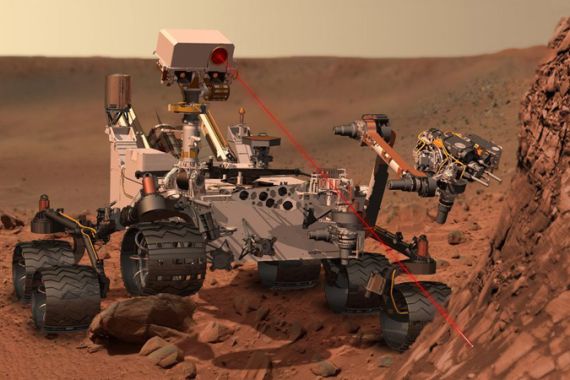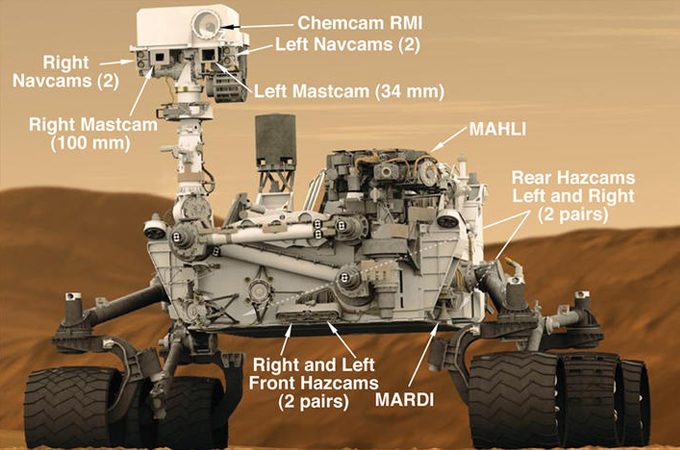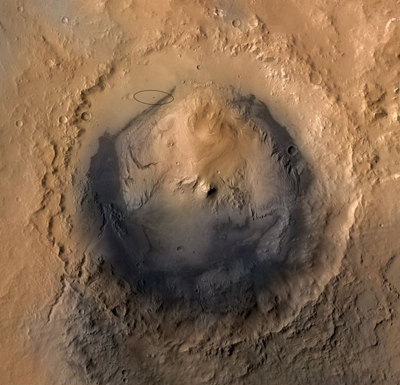‘Curiosity’ will spearhead new understandings of Mars
The landing of Curiosity alone will be an engineering triumph; anything the rover does after will be a scientific bonus.

Be under no illusion, Mars is about to get dominated.
A nuclear-powered, one-tonne robotic rover armed with a rock-burning laser and a set of heavy-duty drills is currently preparing to land on Mars. Its mission is to carry out a vast array of experiments to help mankind understand the Red Planet’s suitability for life and, ultimately, to help answer the age-old philosophical question: Is life on Earth special?
Keep reading
list of 4 itemsCould shipping containers be the answer to Ghana’s housing crisis?
Thousands protest against over-tourism in Spain’s Canary Islands
Holding Up the Sky: Saving the Indigenous Yanomami tribe in Brazil’s Amazon
After nearly nine months of gliding through interplanetary space, NASA’s Mars Science Laboratory, known as “Curiosity”, will feel Martian dirt crunching under its six wheels at 1:31am EDT (5:31am GMT) on Monday after the (hopefully) successful culmination of the “seven-minutes of terror” – a moniker for the mission’s entry, descent and landing (EDL).
 |
| NASA’s Mars Science Laboratory spacecraft – sealed inside its payload fairing – launched on November 26, 2011 will arrive on Mars on August 5, 2012 [NASA] |
Entry
As those seven minutes begin, Curiosity’s tough capsule – known as an “aeroshell” – will hit the top of the Martian atmosphere at a speed of over 13,000 miles per hour and, through the dynamic pressure of atmospheric gases buffeting its heatshield, the vehicle will rapidly slow to 1,000 miles per hour. Although it will be a violent ride, the aeroshell is able to distribute its weight so the vehicle can experience lift – much like an aircraft’s wing experiences lift – and stabilising thrusters will keep it pointing in the right direction, allowing the vehicle to use entry into the atmosphere as a means to steer it on target. It is an ingenious flight profile to say the least.
To any hypothetical Martians living on the planet’s surface, this strange meteor would streak high across the sky toward Gale Crater, a 154-kilometre wide impact crater in the Martian landscape with a conspicuous 5.5-kilometre high mountain in its centre. But the Martians would be in for a shock as they watch a carefully choreographed series of steps unfold – parachute opening, pyrotechnic bolts firing and heatshield being jettisoned away – heralding the start of arguably the most dramatic part of Curiosity’s mission.
Descent
“This huge parachute that we’ve got will only slow us down to about 200 miles per hour, and that’s not slow enough to land,” says Tom Rivellini, NASA EDL Engineer, in the dramatic NASA “7 minutes of terror” video. “So we’ve got no choice; we’ve got to cut it off… and then come down on rockets.”
This means that Curiosity will detach itself from the backshell of its now bottomless capsule (having just jettisoned the spent heatshield) and parachute, and drop as if beginning a kamikaze freefall. Fortunately, this is no freefall – Curiosity will ignite rocket engines attached to its surrounding frame, turning a terrifying drop into a graceful, controlled descent.
Once the rockets have gained control, Curiosity’s radar will guide the craft toward Gale Crater. That crater is Curiosity’s intended target and, because of the incredible thruster system developed by NASA for the mission, Curiosity will have already aligned itself quite nicely with the tiny 20km-by-7km landing zone inside Gale, a plain known as Aeolis Palus. This is the most precise landing ever attempted on Mars.
The rocket engines, controlled by fully-automated onboard computers, will do all the work. At no point during the EDL will mission control be able to send commands or check to see how the landing is proceeding – it takes over 14 minutes for any radio signal to travel across the expanse of space between Earth and Mars, removing humans from the equation.
Landing
As the rover gets closer to the landing zone, the now-famous “Sky Crane” (the frame surrounding Curiosity with rocket engines attached) will lower the rover 21 feet via a tether system to the surface. The Sky Crane is a critical point of the EDL. To avoid the rockets kicking up too much dust (that could cause a hazard to instrumentation on the rover), they need to be kept high and away from the ground. But such a manoeuver isn’t without its risks. The pyrotechnic bolts holding the tethers in place need to trigger at exactly the right moment, just as the rover touches down, so the connection can be severed. If one bolt doesn’t fire, the rover could be dragged across the surface to its potential doom.
But, assuming everything functions as it should, the tethers will detach and the Sky Crane will throttle-up and fly away, leaving the rover standing proud to begin its mission.
Now what?
With a delivery plan as complex, challenging and risky as this, what makes Curiosity so special? Is it really worth a total mission cost of $2.5 billion? The answer couldn’t be simpler: Curiosity is tasked with uncovering the habitat of past or present Martian life. If it does, our robotic emissary may have helped to answer one of the biggest questions of our time: Earth isn’t the only place where life can get a foothold. We are no longer special. It’s no leap of the imagination to think that if a world as “barren” as Mars could harbour even the most basic of lifeforms, perhaps life is possible elsewhere in our galaxy. The possibilities will seem endless.
However, Curiosity, for all its advanced experiments and tools, cannot look for life directly. It is limited to looking for the conditions for life. This means it will build upon the knowledge we’ve gained from previous (and current) missions to Mars in an attempt to find more “missing pieces” of the puzzle of Mars’ geology, climate and organics.
 |
| The Curiosity rover has a suite of nine hard-mounted cameras [NASA/JPL-Caltech] |
For example, Curiosity will zap exposed rock up to seven metres from the rover, vapourising the surface with a remote sensing apparatus called ChemCam. This instrument will be able to analyse the vapour and decipher what minerals the rock contains. This is the first time such a laser has been used on a planetary mission.
Naturally, like past rovers, Curiosity will also have an advanced suite of cameras that will be used to survey the Martian landscape, help it navigate and avoid hazards. Also, a camera is attached to the rover’s robotic arm, so microscopic images of samples can be studied. And there’s the camera that will photograph the mission’s descent through the atmosphere, providing a bird’s-eye view of Gale Crater during approach. One of the first and most dramatic scenes likely to come from the rover will be that of a rocky terrain overshadowed by a huge mountain. It will be like nothing we’ve ever witnessed before.
Other instrumentation includes an experiment that will monitor meteorological conditions; a set of spectrometres that will analyse samples of Martian soil to look for signs of organic compounds; an instrument that will “sniff out” water ice locked in the layers just below the surface. Also, in an effort to understand whether Mars could, one day, become a suitable place for humans to live, one experiment will take direct measurements of the hazardous radioactive environment.
Climb, rover, climb!
All of the ten major experiments that Curiosity will operate will have a vast region to study. To our hypothetical Martians, the six-wheeled robot will look more like an invader than an explorer – it’s a nuclear-powered tank the size of a Mini Cooper that can travel day or night, which fires a rock-burning laser. It will be relentless, trekking up a huge mountain to seek out and sample any interesting geological or organic thing.
This is one of the key reasons for Gale Crater being the landing site – it features a mountain in its centre. After the meteorite impact that formed the crater billions of years ago, the pressure of the surrounding crater rim caused the convex shape to slump with gravity, forcing the centre upward. This forcing has inevitably exposed a huge wealth of geological history locked within layers of the mountain. NASA intends to send the laser-toting rover up the mountain’s slopes, taking samples as it goes, revealing eons of planetary history.
On the shoulders of rovers
This mission will be in stark contrast to its predecessors, Mars Exploration Rovers Spirit and Opportunity that landed in 2003. The two tenacious solar powered rovers – one of which, Opportunity, still soldiers on to this day – are limited in that they depend on the Sun to power their instrumentation. Curiosity – powered by a radioactive fuel source (known as a radioisotope thermoelectric generator, or RTG) – will be able to work day and night; summer or winter. It’s a “rover on steroids” with a primary mission of 687 Earth days (one Martian year) with the potential to power on for a lot longer.
 |
| The most precise landing on Mars ever attempted will be inside the Gale Crater, with the rover’s destination the mountain at its centre – Mount Sharp [NASA] |
By comparison, Spirit and Opportunity had a primary mission of three months; Spirit outlived its “warranty” by seven years. After nearly 22 miles of roving, Opportunity remains operational to this day. Curiosity may be bigger, more advanced and stronger than Spirit and Opportunity, but it still has some very big solar panelled shoes to fill!
An engineering triumph
There’s little doubt that once Curiosity lands, it will give us an unprecedented look at a region of Mars we know little about. Since the 1970s we’ve seen landers and rovers land on Martian plains and polar regions. The best thing about these relatively obstacle-free regions (ignoring the huge boulders that litter the landscape) is that a wide landing zone can be selected. Curiosity is different – its EDL will be the most precise landing system ever devised for a Mars mission, allowing the rover to be placed in the guts of a crater. Not only that, NASA will be able to place the rover right next to Gale Crater’s mountain. The landing of Curiosity alone will be an engineering triumph; anything that the rover does after will be a scientific bonus.
Of course, that “bonus” would be finding further evidence for water just below the surface and mineral evidence for the presence of ancient water held in the rocks Curiosity will zap, grind and sample. Should it find organic molecules in the soil, we’ll build on our knowledge for the habitable potential of the Red Planet.
In short, if the Mars Science Laboratory becomes half of the scientific goldmine it is predicted to be, it will surely invigorate a boost in NASA funding. Sadly, politics isn’t as predictable as that, and with only one major Mars mission planned after Curiosity – the Mars Atmosphere and Volatile Evolution (MAVEN) mission scheduled for launch in 2013 – it’s hard to be optimistic for future NASA flagship robotic missions to Mars in the near term.
Reality check
For all the preparation, engineering and cutting-edge science that has gone into making Curiosity the success it is predicted to be, it’s time for a reality check.
The reason why there is so much hype surrounding the famous EDL – or “7 minutes of terror” – is that landing on Mars is risky. There is never a “safe bet” where missions to Mars are concerned. Although NASA has fared well in recent years – landing Mars Pathfinder in 1997, the Mars rovers Spirit and Opportunity in 2003 and Mars Phoenix in 2008 – it has seen its failures including the Mars Climate Orbiter and Polar Lander in 1999. Out of 13 missions, NASA has seen five failures. It may be a better track record than Russia (that has seen 15 failed missions and only four partial successes), but Mars should never be taken for granted.
So as we watch the clock count down to the anxious wait in the early hours of Monday morning, we can only wish Curiosity a safe landing. Everything else is in the hands of the NASA’s engineering prowess and a heavy dose of Martian good luck.
Ian O’Neill is Space Science Producer for Discovery News. He is also the founder and editor of space blog Astroengine.
Follow him on Twitter: @astroengine
